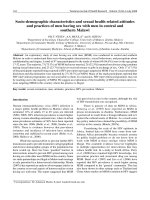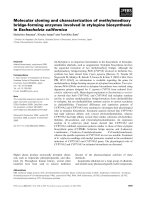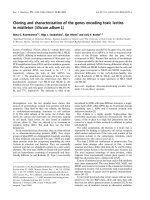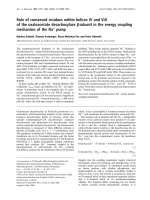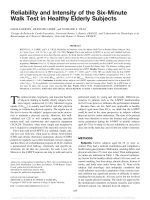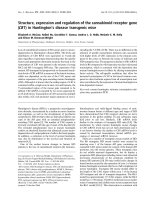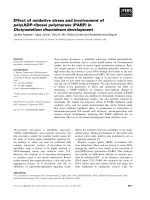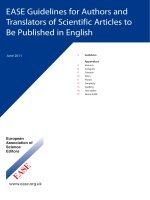Roles and relationship of gasotransmitters hydrogen sulfide nitric oxide in myocardial infarction
Bạn đang xem bản rút gọn của tài liệu. Xem và tải ngay bản đầy đủ của tài liệu tại đây (6.55 MB, 276 trang )
ROLES AND RELATIONSHIP OF GASOTRANSMITTERS
HYDROGEN SULFIDE AND NITRIC OXIDE
IN MYOCARDIAL INFARCTION
CHUAH SHIN CHET
B.Sc. (Hons), National University of Singapore
A THESIS SUBMITTED
FOR THE DEGREE OF DOCTOR OF PHILOSOPHY
DEPARTMENT OF PHARMACOLOGY
NATIONAL UNIVERSITY OF SINGAPORE
2009
i
ACKNOWLEDGEMENTS
First and foremost, I would like to express my heartfelt gratitude to my project supervisor,
Associate Professor Zhu Yi-Zhun for the great opportunity to work on this interesting
project and also for his invaluable advice, patient guida nce and encouragement
throughout the course of this project.
I would also like to thank Dr Wang Hong and Dr Wang Zhongjing for their helpful input
and constructive suggestions which were instrumental to the development of the project.
My sincere thanks also goes out to past and present members of Dr. Zhu’s lab for the
friendship, support and bantering of ideas along the way. Specifically, I would like to
thank Miss Wong Wan Hui, who has done an excellent job in maintaining an orderly lab
environment, and also for providing assistance with the purchasing o f necessary materials.
It was also a great pleasure to work alongside Ms Loh Kok Poh, my fellow post-graduate
lab-mate, who has been very encouraging.
I would like to extend my appreciation to members of the Life Sciences Institute
Cardiovascular Biology Group, academic and non-academic staff of the Department of
Pharmacology, N US for their kind help rendered a long the way.
I would also like to express my gratitude to the National University of Singapore for
granting me this Ph.D. research scholarship, hence allowing me to pursue my interest in
research.
Last but not least, I would like to express my heartfelt appreciation to my family and
husband KG. Without their strong support and loving encouragements, this project would
not ha ve reached fruition.
ii
TABLE OF CONTENTS
ACKNOWLEDGEMENTS i
TABLE OF CONTENTS ii
SUMMARY viii
LIST OF TABLES xi
LIST OF FIGUR ES xii
LIST OF ABBREVIATIONS xvii
LIST OF PUBLICATIONS xx
CHAPTER I INTRODUCTION 1
1.1 GENERAL OVERVIEW 2
1.2 MYOCARDIAL INFARCTION (MI) 3
1.2.1 Pathophysiology and Management of Myocardial Infarction 3
1.2.2 Animal Models of Acute Myocardial Infarction (AMI) 4
1.2.3 Experimental Model of MI: Simulation of Hypoxic Conditions in vitro 5
1.2.3.1 H9c2 6
1.2.3.2 Rat Neonatal Cardiomyocytes 7
1.3 GASOTRANSMITTERS 7
1.3.1 Hydrogen Sulfide 10
1.3.1.1 Overview of H
2
S 10
1.3.1.2 Biosynthesis of H
2
S 10
1.3.1.3 Metabolism of H
2
S 13
1.3.1.4 Roles of H
2
S in the Cardiovascular System 15
1.3.1.4.1 Effect of H
2
S on Vascular Tone 15
1.3.1.4.2 Effect of H
2
S on the Ischemic Heart 15
1.3.1.5 S-allylcysteine (SAC) as a Novel H
2
S Donor 17
1.3.1.5.1 Garlic as a Cardioprotective Agent 17
1.3.1.5.2 SAC as a Cardioprotective Agent 18
1.3.2 Nit ric Oxide 20
1.3.2.1 Overview of NO 20
1.3.2.2 Biosynthesis of NO 21
1.3.2.3 NOS Isoforms 22
1.3.2.4 NO Metabolism 23
1.3.2.5 Roles of NO in the Cardiovascular System 24
1.3.2.6 Sildenafil as a Novel Substrate for Endogenous NO Production 27
1.3.2.6.1 Overview of Sildenafil 27
1.3.2.6.2 Sildenafil as a Cardioprotective Agent 28
1.3.3 Crosstalk between H
2
S AND NO 30
1.3.3.1 H
2
S and NO: Common Functions 31
1.3.3.2 H
2
S and NO: Evidence for Crosstalk 31
1.3.3.3 H
2
S and NO: Nitrosothiol Formation 33
1.4 HYPOXIA-INDUCIBLE FACTOR-1α (HIF-1α ) 34
1.4.1 Hypoxia 34
1.4.2 Discovery of HIF 35
1.4.3 Regulation of HIF 36
iii
1.4.4 HIF-1α and the Cardiovascular System 39
1.4.5 Downstream Targets of HIF in the Heart 40
1.4.5.1 iNOS as a Downstream Target of HIF 41
1.5 PI3K/AKT SIGNALING PATHWA Y 42
1.6 RESEARCH INTEREST AND OBJECTIVES 44
CHAPTER II MATERIALS AND METHODS 48
2.1 MATERIALS 49
2.1.1 Drugs 49
2.1.2 Chemicals 50
2.2 METHODS 51
2.2.1 Anima l 51
2.2.1.1 Animal Model of Acute Myocardial Infarction (AMI) 51
2.2.2 Cell Culture 52
2.2.2.1 H9C2 52
2.2.2.2 Neonatal Rat Primary Cardiomyocytes 52
2.2.2.3 Isolation of Primary Cardiomyocytes 53
2.2.2.4 Hypoxia Model 54
2.3 EXPERIMENTAL PROTOCOL 55
2.3.1 Experimental Protocol 1: SAC exerts Cardioprotection in AMI via a H
2
S-related pathway
with Concomitant NO Production 56
2.3.2 Experimental Protocol 2: NO-mediated Cardioprotection by Sildenafil involves a CSE/
H
2
S-related pathway during Myocardial Ischemia 58
2.3.3 Exp e r imental Protocol 3: Relationship between H
2
S and NO in a Rat Model of AMI 60
2.3.4 Experimental Protocol 4: H
2
S e xerts Cardioprotection by enhancing HIF-1α activation and
iNOS expression through the PI3K/Akt-dependent pathway 62
2.4 EXPERIMENTAL METHODS 65
Anima l
2.4.1 Measurement of Infarct Size 65
2.4.2 Measurement of Hypertrophy Index 65
2.4.3 Hemodynamic Measurements 66
2.4.3.1 Blood Pressure 66
2.4.3.2 Electrocardiograms and Heart Rate 66
2.4.4 Morphological Examination— Hematoxylin & Eosin staining 67
Cell Cu lture
2.4.5 Cell Count 68
2.4.6 MTT Assay 68
2.4.7 LDH Assay 69
2.4.8 Trypan Blue Exclusion Assay 70
Biochemical Assays
2.4.9 Measurement of CSE Activity in the Left Ventricle 71
2.4.10 Measurement of H
2
S Concentration in the Plasma 72
2.4.11 Measurement of Nitrate/Nitrite (NOx) Concentration in Left Ventricle and Plasma 73
2.4.12 Measurement of Nitrate/Nitrite Concentration in Cell Medium 74
2.4.13 Total RNA Isolation from Animal Tissue 74
2.4.14 Total RNA Isolation from Cell Sample 75
2.4.15 RNA Quantitation 76
iv
2.4.16 Reverse transcription-Polymerase Chain Reaction (RT-PCR) 76
2.4.17 Collection of Nuclear and Cytoplasmic Extracts 79
2.4.18 Electrophoretic Mobility Shift Assay (EMSA) 79
2.4.19 Protein Extraction from Animal Tissue 81
2.4.20 Protein Extraction from Cells 82
2.4.21 Western Blot 82
2.5 STATISTICAL ANALYSIS 84
CHAPTER III S-ALLYLCYSTEINE MEDIATES CARDIOPROTECTION VIA A HYDROGEN
SULPHIDE-RELATED PATHWAY WITH CONCOMITANT NITRIC OXIDE PRODUCTION 85
3.1 RESULTS………………………………… ……………………… …………86
3.1.1 Preliminary Study…………………………… ………………… ….…….86
3.1.2 Survival Rate after Myocardial Infarction (MI)… ……….……… ………87
3.1.3 Exclusion Criteria……………… ………………………… ………… …87
3.1.4 Infarct Size…………………………………………………… ……………88
3.1.5 Ventricular Hypertrophy………………………… …………… ……… 89
3.1.6 Hemodynamic Parameters………………………………………… ………90
3.1.6.1 Blood Pressure……………………………… ………………………… ……….90
3.1.6.2 Electrocardiograms (ECGs) ……………… ……………………… ……… 91
3.1.6.3 Heart Rate……………………………………… ……………………….……….94
3.1.7 Morphological Examination………………………………………… …….94
3.1.8 CSE Activity in the Left Ventricle…………………………………… ……95
3.1.9 Plasma H
2
S Concentration…………………………………………… ……97
3.1.10 CSE Protein Expression……………………………… ……………… ….98
3.1.11 Nitrate/Nitrite Levels in the Left Ventricle…………………… ……… 100
3.1.12 Plasma NOx Concentration…………………………… ……………… 101
3.2 DISCUSSION………………………………………………………………… 103
3.2.1 H
2
S as a Cardioprotective Agent………………………………………… 103
3.2.2 Garlic as a Cardioprotective Agent……………………………………… 104
3.2.3 S-allycysteine (SAC) as a Cardioprotective Agent……………………… 104
3.2.4 SAC Improved Survival and Infarct Size after AMI…………………… 105
3.2.5 Effect of SAC on BP, ECG and Heart Rate……………………………… 106
3.2.6 SAC Improved Morphology of Ischemic LV………………………….… 107
3.2.7 Participation of H
2
S/CSE Pathway in SAC-Mediated Cardioprotection… 108
3.2.8 Participation of NO in SA C-Mediated Cardioprotection………………… 110
3.2.9 Summary of Findings for Experiment Protocol 1……………………… 110
CHAPTER IV NO-MEDIATED CARDIOPROTECTION BY SILDENAFIL IN MYOCARDIAL
ISCHEMIA INVOLVES A H
2
S/CSE PATHWAY ……………………… ………………… 112
4.1 RESULTS……………………………… ………………………………………113
4.1.1 Survival Rate after Acute Myocardial Infarction… ………… ………113
4.1.2 Exclusion Criteria………………………………… ……………… …113
4.1.3 Infarct Size………………………… ……………………………114
4.1.4 Ventricular Hypertrophy……………………… …………………………114
4.1.5 Hemodynamic Parameters………………………… ……………………115
4.1.5.1 Blood Pressure……… ……………………………… …………………115
v
4.1.5.2 Electrocardiograms …………… ……………… …………………116
4.1.5.3 Heart Rate……………………………………… ………………119
4.1.6 NOx Content in the Left Ventricle……………… ……………119
4.1.7 Plasma NOx Concentration………………………………… …………120
4.1.8 Protein Expressions of eNOS and nNOS……………… ………121
4.1.9 iNOS Gene Expression………………………………… ……123
4.1.10 iNOS Protein Expression……………………………… …124
4.1.11 Effect of Sildenafil on H
2
S Production in the Left Ventricle……… …124
4.1.12 Effect of Sildenafil on Plasma H
2
S Concentration…… …… …125
4.1.13 Effect of Sildenafil on CSE Protein Expression……… ………… …126
4.2 DISCUSSION…………………………… 128
4.2.1 Sildenafil as a Cardioprotective Agent………………… ………… 128
4.2.2 Sildenafil Improved Survival and Limits Infarct Development in AMI… 129
4.2.3 Effect of Sildenafil on Hemodynamic Parameters……………… 130
4.2.4 Effect of Sildenafil on Nitrate/Nitrite Concentration in the Body……… 132
4.2.5 Effect of Sildenafil on the Expressions of NOS Isoforms…………… 133
4.2.6 H
2
S Involvement in Sildenafil-mediated Cardioprotection……… 134
4.2.7 Summary of Findings for Experiment Protocol 2……………………… 135
CHAPTER V ROLES AND RELATIONSHIP OF HYDROGEN SULFIDE AND NITRIC OXIDE
IN A RAT MODEL OF ACUTE MYOCARDIAL INFARCTION.……………………… 137
5.1 RESULTS …… 138
5.1.1 Survival Rate after Acute Myocardial Infarction…… ………… … 138
5.1.2 Exclusion Criteria……………………… 138
5.1.3 Infarct Size…………………………………………… ……… 139
5.1.4 Ventricular Hypertrophy……………………………… … 139
5.1.5 Hemodynamic Parameters……………………………… ………… 140
5.1.5.1 Blood Pressure…………………………………… 140
5.1.5.2 Electrocardiograms…………………………………… ………… 141
5.1.5.3 Heart Rate……………… …………… 144
5.1.6 CSE Gene Expression……………………… …………144
5.1.7 CSE Protein Expression…………………………… …….146
5.1.8 H
2
S Production in the Left Ventricle………………………… … ……147
5.1.9 Plasma H
2
S Concentration……………………………… …148
5.1.10 Gene Expressions of NOS Isoforms……………………………… …149
5.1.11 Protein Expressions of NOS Isoforms…………………………… …… 152
5.1.12 Nitrate/ Nitrite (NOx) Content in the Left Ventricle……………… … 155
5.1.13 Plasma Nitrate/Nitrite Concentration…………………… 156
5.1.14 HIF-1α Protein Expression………………………………………… … 157
5.1.15 HIF-1α Gene Expression………………………………… 158
5.2 DISCUSSION……………………………………………………… ……….160
5.2.1 Interplay between H
2
S and NO…………… ….160
5.2.2 Exogenous H
2
S and NO Ameliorates MI…………… …162
5.2.3 Effect of H
2
S and NO on BP, ECG and Heart Rate………… 164
5.2.4 Effect of H
2
S and NO on the CSE/H
2
S System……… 165
5.2.5 Effect of H
2
S and NO on the NOS/NO System…………… 167
5.2.6 Effect of H
2
S and NO on the HIF System………………………… 169
5.2.7 Summary of Findings for Experiment Protocol 3…………………… 170
vi
CHAPTER VI H
2
S EXERTS CARDIOPROTECTION BY ENHANCING HIF-1α ACTIVATION
AND iNOS EXPRESSION WITH THE INVOLVEMENT OF PI3K/AKT PATHWAY IN H9C2
AND PRIMARY CARDIOMYOCYTES……………………… …………… ……172
6.1 RESULTS………………………………… …………… …… ………173
6.1.1 Optimization of Hypoxia Conditions………… ………… …………173
6.1.1.1 Selection of Hypoxia Model………………… ………… ………173
6.1.1.2 Optimization of CoCl
2
Concentration…………… ……174
6.1.1.3 Optimization of Hypoxia Duration………………… ……… ….176
6.1.1.4 Optimization of NaHS Concentration…………… 177
6.1.2 Assessment of Cell Viability…………………………………… … 178
6.1.2.1 MTT Assay…………………………………………………… 178
6.1.2.2 LDH Assay……………………………………… ……………179
6.1.2.3 Trypan Blue Exclusion Assay……………………… ………… 180
6.1.2.3.1 H9C2………………………………………… ……… 180
6.1.2.3.2 Cardiomyocytes……………………………………… 181
6.1.3 Involvement of HIF-1α/iNOS Pathway in H
2
S-Mediated Cardioprotection ……182
6.1.3.1 Protein Expression of HIF-1α in Total Ce ll Lysates……… ……182
6.1.3.2 Gene Expression of HIF-1α …………………… ……184
6.1.3.3 Protein Expression of HIF-1α in Nuclear and Cytoplasmic Fractions 186
6.1.3.4 Electrophoretic Mobility Shift Assay (EMSA) for HIF-1α Binding 188
6.1.3.5 iNOS Gene Expression……………………………………… 190
6.1.3.6 iNOS Protein Expression……………………………………… 192
6.1.3.7 NO Production………………………………………… 193
6.1.4 Involvement of PI3K/Akt Pathway in H
2
S-Mediated Cardioprotection……… 195
6.1.4.1 Protein Expression of Akt…………………… …………… 195
6.1.4.2 Protein Expression of p-Akt………………………… 197
6.1.4.3 Akt Activation……………………………… ……… 199
6.1.4.4 Protein Expression of eNOS ………………… …… 201
6.1.4.5 Protein Expression of p-eNOS…………… …… 203
6.1.4.6 eNOS Activation………………………………… 205
6.1.4.7 Nitrate/Nitrite Concentration …………….………… 207
6.1.5 Protein Expression of HIF-1α…………………………… 209
6.2 DISCUSSION…………………………………………………… …211
6.2.1 Overview of HIF-1……………………………………… …… ….211
6.2.2 HIF-1 Involvement in NaHS-mediated Cardioprotection… … …212
6.2.3 Optimization of Hypoxia Model and Conditions……………… 213
6.2.4 Determination of NaHS Concentration………………………… 215
6.2.5 Cell Viabilities of H9C2 and Cardiomyocytes after Hypoxia…… 215
6.2.6 Effect of NaHS on HIF-1α Protein and Gene Expressions……… 218
6.2.7 Effect of NaHS on HIF-1α Transcriptional Activity…………… 219
6.2.8 Effect of NaHS on iNOS Expressions and NO Production……… 220
6.2.9 Involvement of PI3K/Akt Pathway in NaHS-mediated Cardioprotection 222
6.2.10 PI3K Lies Upstream of HIF-1α Signaling……………………… 224
6.2.11 Summary of Findings for Experiment Protocol 4……………… 225
vii
CHAPTER VII S UMMARY OF CONTRIBUTIONS AND FUTURE DIRECTIONS 227
7.1 SUMMARY OF CONTRIBUTIONS………………………………… 228
7.2 FUTURE DIRECTIONS………………………………………… 231
REFERENC ES ………………………………….…… ……………………………… 233
viii
SUMMARY
Hydrogen sulfide (H
2
S) and nitric oxide (NO) are gasotransmitters endogenously
synthesized in the body, sharing several common roles such as vasodilation. Additionally,
both are implicated in the disease progression of myocardial infarction (MI), which will
be examined in this study. Furthermore, several works have investigated their interaction
in the vascular system, but due to the disparity in outcomes observed, their relationship is
far from clear. Thus far, the interplay between H
2
S and NO in the cardiovascular system
has not been researched on. For this thesis, we aim to elucidate the roles and relationship
of H
2
S and N O in MI, and s hed light on the mechanisms involved.
In t he first study, S-allylcysteine (SAC) is proposed to be a novel H
2
S donor as it exerted
cardioprotection through a CSE (H
2
S-synthesizing enzyme)/H
2
S-related pathway. Pre-
treatment with SAC before MI induction lowered mortality and reduced infarct size. This
was accompanied by an increase in left ventricular (LV) H
2
S production and plasma H
2
S
concentration. Co-treatment with propargylglycine (PAG; CSE inhibitor) which blocked
H
2
S production and lowered plasma H
2
S concentration was shown to abrogate the
improvements in survival and infarct. Furthermore, SAC increased NO content in the LV
and plasma, implicating NO involvement in SAC-mediated cardioprotection.
In the next study, sildenafil brought about cardioprotection in MI via a NO-related
pathway with the concomitant involvement of H
2
S. Sildenafil improved survival and
attenuated infarct size. This was via a NOS/NO pathway as protein and gene expressions
of eNOS, nNOS and iNOS were drastically upregulated with an associated enhancement
in LV and plasma NO levels. Interestingly, sildenafil also stimulated CSE activity by
ix
increasing H
2
S production in the heart without affecting CSE’s protein expression,
providing yet another evidence for the interaction between H
2
S and NO.
The third study examined this crosstalk on a common platform using both donors and
inhibitors of H
2
S and NO in in vivo MI models. NaHS and molsidomine attenuated
infarct enlargement and improved survival whilst inhibitors of CSE and NOS exacerbated
these. Crosstalk is evidently present between H
2
S and NO. Firstly, NaHS increased LV
and plasma NO levels due to an upr egulation of eNOS and iNOS gene and protein
expressions. Consistent stimulation of NOS/NO pathway by NaHS may involve HIF as
NaHS upregulated HIF-1 protein expression drastically. This will be further examined in
the next study. Secondly, blockade of H
2
S production with PAG resulted in higher NO
levels in both LV and plasma. This may be due to an increment in NOS activities as
protein expressions were unaltered. Thirdly, NOS inhibitor L-NAME increased CSE
protein expression, which was accompanied by an increase in LV H
2
S production.
Transcription factor HIF-1 plays a pivotal role in initiating the transcription of hypoxia-
sensitive genes to improve cellular adaptation to hypoxia. During hypoxia, NaHS
enhanced HIF-1 protein expression and transcriptional activity in cardiac cells. Moreover,
following NaHS treatment, HIF-1 activation upregulated downstream target iNOS and
increased NO production. Additionally, numerous studies have implicated PI3K/Akt
participation during hypoxia to mediate HIF-1α activation. Hence, its invo lvement was
determined. NaHS-pretreated hypoxic cells had higher Akt and eNOS phosphorylations,
which were abrogated when PI3K inhibitors were applied, indicating PI3K/Akt pathway
involvement in this mode of cardioprotection. Furthermore, it was determined that this
pathway lies upstream of HIF-1α.
x
In conclus ion, this study provided evidence for a cardioprotective role of H
2
S and NO,
and support for their crosstalk in MI. Furthermore, we elucidated that H
2
S exerted its
cardioprotection by enhancing HIF-1α activation and its do wnstream target iNOS with
the participation of PI3K/Akt/eNOS pathway.
xi
LIST OF TABLES
Table 1.1 Properties and characteristics of gasotransmitters H
2
S, NO and CO.
Table 2.1 Treatment groups for h9c2.
Table 2.2 Treatment groups for cardiomyocytes.
Table 2.3 Primer sequences for eNOS, iNOS, nNOS, CSE, HIF and GAPDH.
Table 2.4 PCR amplification conditions for eNOS, iNOS, nNOS, CSE, HIF and
GAPDH.
Table 2.5 Infor mation and conditions of bot h primary and seconda ry antibod ies used
for Western Blot.
Table 3.1 Mortality and infarct sizes of rats treated with 50mg, 100mg and
200mg/kg b.w./day of SAC.
Table 3.2 Heart rates for saline, SAC, SAC+PAG and PAG-treated rats.
Table 4.1 Survival rate of the animals in saline, sildenafil and L-NAME-treated
groups following MI
Table 4.2 Heart rates for saline, sildenafil and L-NAME treated rats.
Table 5.1 Survival rates of rats 48h after induction of myocardial infarction in saline,
NaHS, molsidomine, PAG and L-NAME treated groups.
Table 5.2 Heart rates for saline, NaHS, molsidomine, PAG and L-NAME treated
rats.
xii
LIST OF FIGURES
Figure 1.1 Endo genous enzymatic prod uction of H
2
S.
Figure 1.2 Non-enzymatic production of H
2
S.
Figure 1.3 Metabolism of H
2
S in the bod y.
Figure 1.4 Structure of sulfur-containing compounds derived from garlic.
Figure 1.5 CSE-SAC interaction model.
Figure 1.6 Endo genous synt hesis of NO from L-arginine in animal cells.
Figure 1.7 Domain structure of human HIF-1α.
Figure 1.8 Oxygen-dependent regulation of HIF-1 stabilization and transactivation.
Figure 2.1 Schematic representation of experimental protocol 1.
Figure 2.2 Schematic representation of experimental protocol 2.
Figure 2.3 Schematic representation of experimental protocol 3.
Figure 2.4 Schematic representation of experimental protocol 4 (h9c2).
Figure 2.5 Schematic representation of experimental protocol 4 (myocytes).
Figure 3.1 Survival rates of saline, SAC, SAC+PAG and PAG-treated groups after
myocardial infarction (n ≥ 23).
Figure 3.2 Infarct sizes and hypertrophy indices of rats in saline, SAC, SAC+PAG
and P AG-treated groups.
Figure 3.3 Blood pressures (mmHg) of rats in saline, SAC, SAC+PAG and PAG-
treated groups.
Figure 3.4 ECG charts for saline, SAC, SAC+PAG and PAG treatment groups.
Figure 3.5 Representative morphology of heart tissue of sham, saline, SAC,
SAC+PAG and PAG-treated animals.
Figure 3.6 CSE activity in the left ventricles of MI and sham-operated rats in all
treatment groups.
xiii
Figure 3.7 Plasma H
2
S concentration of MI and sham-operated rats in all treatment
groups.
Figure 3.8 CSE protein expressions in all treatment groups of MI-operated rats.
Figure 3.9 CSE protein expressions in all treatment groups of sham-operated rats.
Figure 3.10 Left ventricular NOx levels in saline, SAC, SAC+PAG and PAG
treatment groups of both MI and sham-operated animals.
Figure 3.11 Plasma NOx levels in saline, SAC, SAC+PAG and PAG treatment groups
of bo th MI and sham-operated animals.
Figure 4.1 Infarct sizes and hypertrophy indices of rats in saline, sildenafil and L-
NAME-treated groups.
Figure 4.2 Blood pressure (mmHg) of rats in saline, sildenafil and L-NAME treated
groups.
Figure 4.3 ECG charts for saline, sildenafil and L-NAME treatment groups.
Figure 4.4 NOx levels in the left ventricles of MI and sham-operated rats in saline,
sildenafil and L-NAME treated groups.
Figure 4.5 NOx concentration in plasma samples of MI and sham-operated rats in
saline, sildenafil and L-NAME treated groups.
Figure 4.6 eNOS protein expression in MI-operated rats in saline, sildenafil and L-
NAME treated groups.
Figure 4.7 nNOS protein expression in MI-operated rats in saline, sildenafil and L-
NAME treated groups.
Figure 4.8 Gene expressions of iNOS in saline, sildenafil and L-NAME treated
groups.
Figure 4.9 Protein expression of iNOS in MI-operated rats of saline, sildenafil and L-
NAME treated groups.
Figure 4.10 Effects of sildenafil on H
2
S production in all treatment groups.
Figure 4.11 Plasma H
2
S concentration in both MI and sham-operated rats treated with
saline, sildenafil and L-NAME.
Figure 4.12 CSE protein expression in MI-operated rats in saline, sildenafil and L-
NAME treated groups.
xiv
Figure 5.1 Infarct sizes and hypertrophy indices of rats in saline, NaHS, molsidomine,
PAG and L-NAME-treated groups.
Figure 5.2 Blood pressure (mmHg) of rats in saline, NaHS, molsidomine, PAG and
L-NAME treated groups.
Figure 5.3 ECGs of saline, NaHS, molsidomine, PAG and L-NAME-treated rats.
Figure 5.4 CSE gene expression in sham (saline-treated sham-operated), MI-operated
saline, NaHS, molsidomine, PAG and L-NAME treated groups.
Figure 5.5 Protein expression of CSE in sham-operated saline-treated group (grey)
and M I-operated (black) saline, NaHS, molsidomine, PAG and L-NAME
treated groups.
Figure 5.6 Rate of H
2
S prod uction in bo th MI and sham-ope rated rats in the various
treatment groups.
Figure 5.7 Plasma H
2
S concentrations in bot h MI and s ham-operated rats in the
various treatment groups.
Figure 5.8 eNOS gene expressions in sham (grey) and MI (black)-operated rats
subjected to different drug treatments.
Figure 5.9 nNOS gene expressions in sham (grey) and MI (black)-operated rats
subjected to different drug treatments.
Figure 5.10 iNOS ge ne expressions in sham (grey) and MI (black)-operated rats
subjected to different drug treatments.
Figure 5.11 eNOS protein expressions in s ham (grey) and MI (black)-operated rats
subjected to different drug treatments.
Figure 5.12 nNOS protein expressions in s ham (grey) and MI (black)-operated rats
subjected to different drug treatments.
Figure 5.13 iNOS protein expressions in sham (grey) and MI (black)-operated rats
subjected to different drug treatments.
Figure 5.14 NOx levels in the left ventricles of MI and sham-operated rats in saline,
NaHS, molsidomine, PAG and L-NAME treated groups.
Figure 5.15 Plasma NOx concentrations of MI and sham-operated rats in saline, NaHS,
molsidomine, PAG and L-NAME treated groups.
xv
Figure 5.16 HIF-1α protein expression in sham (grey) and MI (black)-operated rats
subjected to different drug treatments.
Figure 5.17 HIF-1α gene expression in sham (grey) and MI (black)-operated rats
subjected to different drug treatments.
Figure 6.1 Cell viability of h9c2 subjected to various hypoxia models (CoCl
2
, DFX
and hypoxic chamber) for 24h.
Figure 6.2 Cell viability of h9c2 subjected to different concentrations of CoCl
2
for
24h.
Figure 6.3 Cell viability of h9c2 subjected to different durations of hypoxia using
200µM CoCl
2
.
Figure 6.4 Cell viability of h9c2 treated with different concentrations of NaHS (30-
1000µM).
Figure 6.5 Relative cell viability for NC, HC, N300 and H300.
Figure 6.6 LDH release for nor moxic (in grey) and hypoxic (in black) groups treated
with various concentrations of NaHS.
Figure 6.7 Cell viability test (Trypan Blue Exlusion assay) for NC, HC, N300 and
H300.
Figure 6.8 Cell viability test (Trypan Blue Exlusion assay) for NC, HC, N100 and
H100.
Figure 6.9 Protein expression of HIF-1α in h9c2.
Figure 6.10 Protein expression of HIF-1α in myo c ytes.
Figure 6.11 HIF-1α gene expression in NC, HC, N300 and H300 groups of h9c2.
Figure 6.12 HIF-1α gene expression in NC, HC, N100 and H100 groups of
cardiomyocytes.
Figure 6.13 HIF-1α protein expression in cytoplasmic fractions of various treatment
groups of h9c2.
Figure 6.14 HIF-1α protein expression in nuclear fractions of various treatment groups
of h9c2.
Figure 6.15 Binding of HIF-1α protein from h9c2 to HRE in iNOS ge ne pro moter
region.
xvi
Figure 6.16 Binding of HIF-1α protein from myocytes to HRE in iNOS gene promoter
region.
Figure 6.17 iNOS gene expression in NC, HC, N300 and H300 groups of h9c2.
Figure 6.18 iNOS gene expression in NC, HC, N100 and H100 groups of
cardiomyocytes.
Figure 6.19 iNOS protein expression in NC, HC, N100 and H100 groups of
cardiomyocytes.
Figure 6.20 NO production in various treatment groups of h9c2.
Figure 6.21 NO production in various treatment groups of cardiomyocytes.
Figure 6.22 Protein expression of Akt in the various treatment groups of h9c2.
Figure 6.23 Protein expression of Akt in the various treatment groups of myoc ytes.
Figure 6.24 Protein expression of p-Akt in the various treatment groups of h9c2.
Figure 6.25 Protein expression of p-Akt in the various treatment groups of myocytes.
Figure .6.26 Akt activation (p-Akt/Akt ) in the various treatment groups of h9c2.
Figure 6.27 Akt activation (p-Akt/Akt ) in the various treatment groups of myoc ytes.
Figure 6.28 Protein expression of eNOS in the various treatment groups of h9c2.
Figure 6.29 Protein expression of eNOS in the various treatment groups of myoc ytes.
Figure 6.30 Protein expression of p-eNOS in the various treatment groups of h9c2.
Figure 6.31 Protein expression of p-eNOS in the various treatment groups of myoc ytes.
Figure 6.32 eNOS activation (p-eNOS/eNOS) in the various treatment groups of h9c2.
Figure 6.33 eNOS activation in the various treatment groups of myoc ytes.
Figure 6.34 NO production in various treatment groups of h9c2.
Figure 6.35 NO production in various treatment groups of myocytes.
Figure 6.36 Protein expression of HIF-1α in the various treatment groups of h9c2.
Figure 6.37 Protein expression of HIF-1α in the various treatment groups of myocytes.
Figure 7.1 Schematic diagram illustrating the mechanism of NaHS-mediated
cardioprotection during MI.
xvii
LIST OF ABBREVIATIONS
AMI acute myocardial infarction
BP blood pressure
BSA bovine serum albumin
BW body weight
CBP cAMP response element-binding protein
CBS cystathionine - β-synthase
cGMP cyclic guanosine monop hosphate
CHD coronary heart disease
CO carbon monoxide
CoCl
2
cobalt chloride
COX-2 cycloo xygenase-2
CSE cystathionine γ-lyase
C-TAD C-terminus transactivation domain
CV cardiovascular
CVD cardiovascular disease
DFX desferrioxamine
DMSO dimethylsulfoxide
ECG electrocardiogram
EDRF endo thelium-derived relaxing factor
EMSA electrophoretic mobility shift assay
eNOS endothelial nitric oxide synthase
EPO erythropoietin
ERK extracellular signal regulated kinase
FAD flavin adenine dinucleotide
FBS fetal bovine serum
FMN flavin mononucleotide
GC guanyl cyclase
xviii
H
2
S hydrogen sulfide
HC hypoxic control
HIF hypoxia inducible factor
HO heme oxygenase
HR heart rate
HRE hypoxia response element
i.p. intraperitoneal
i.v. intravenous
I/R ischemia/reperfusion
iNOS inducible nitric oxide synthase
LDH lactate dehydrogenase
L-NAME NG-nitro-L-arginine methyl ester
LPS lipopolysacharide
LV left ventricle
MAPK mitogen activated protein kinase
MI myocardial infarction
mitoK
ATP
mitochondrial ATP-sensitive potassium channel
MTT 3-(4,5-HDiHH methylHH thiazolH-2-yl)-2,5-diHphenylH tetrazolium bromide
NAD nicotinamide adenine dinucleotide
NADH reduced nicotinamide adenine dinucleotide
NaHS sodium hydrosulfide
NC normoxic control
nNOS neuronal nitric oxide synthase
NO nitric oxide
NOS nitric oxide synthase
NOx nitrate and nitrite
O
2
superoxide
ODDD oxygen dependent degradation domain
xix
ONOO
peroxynitrite
PAG D, L-propargylglycine
PBS phosphate buffered saline
PCR polymerase chain reaction
PDE-5 phosphodiesterase 5
PE phenylepinephrine
PHD prolyl hydroxylase
PI3K phosphoinositide-3-kinase
PKB protein kinase B
PKC protein kinase C
PKG protein kinase G
pO
2
oxygen partial pressure
rpm revolution per minute
RSNO nitrosothiol
RT-PCR reverse-transcription polymerase chain reaction
SAC S-allylcysteine
S.E.M. standard error mean
SNAP S-ntirosoacetylpenicillamine
SNP sodium nitroprusside
SOD superoxide dismutase
TBS Tris-buffered saline
VEGF vascular endothelial growth factor
vHL von Hippe l-Linda u
VSMC vascular smooth muscle cells
w/v weight per volume
xx
LIST OF PUBLICATIONS
Publications in Jo urnals
1. Chuah S.C., Moore P.K., Zhu Y.Z.
HS-allylcysteine mediates cardioprotection in
an acute myocardial infarction rat model via a hydrogen sulfide-mediated
pathway.
H Am J Phys iol Heart C irc Physiol. 2007 Nov;293(5):H2693-701
2. Zhu Y.Z., C hong C.L., Chuah S.C., Huang S.H., Nai H.S., Tong H.T., Whiteman
M., Moore P.K. Cardioprotective effects of nitroparacetamol and paracetamol in
acute phase of myocardial infarction in experimental rats. Am J Physiol Heart
Circ Physiol. 2006 Feb;290(2):H517-24.
3. Chuah S.C., Zhu Y.Z. The use of animal models to develop novel therapies.
Innovation. 2008 8(2): 23-26.
4. Chuah S.C., Zhu Y.Z. Possible Interactions of Nitric Oxide and Hydrogen
Sulphide in Acute Myocardial Infarction Rats. The Journal of Heart Disease. 2007
July 5(1) 84 (abstract)
5. Chuah S.C., Moore P.K., Zhu Y.Z. NO-mediated cardioprotection by sildenafil
involves the CSE/H2S pathway. (Manuscript in preparation)
6. Chuah S.C., Zhu Y.Z. H
2
S exerts cardioprotection in the ischemic heart by
enhancing HIF-1α activation and iNOS expression with the involvement of
PI3K/Akt pathway (Manuscript submitted to Cellular and Molecular Life
Sciences)
Inte rnational Conference Presentations
1. Chuah S.C., Zhu Y.Z. Possible Interactions of Nitric Oxide and Hydrogen
Sulphide in Acute Myocardial Infarction Rats.
Oral presentation at 13th World Congress on Heart Disease 2007, 28th July-31st
July, Vancouver, Canada.
2. Chuah S.C., Zhu Y.Z. Hydrogen sulphide exerts cardioprotection by enhancing
hypoxia-inducible factor 1 (HIF-1) activation and iNOS expression through
regulation of PI3K/Akt signaling pathway during ischemia.
Oral presentation at The First International Conference of Hydrogen Sulfide in
Biology and Medicine 2009, 26-28
th
June, Shanghai, China.
Recipient of the Young Investigator Award.
INTRODUCTION
1
CHAPTER 1
INTRODUCTION
INTRODUCTION
2
1.1 GENERAL OVERVIEW
Cardiovascular diseases (CVDs) is an umbrella term that covers an array of pathological
conditions that affect the proper functioning of blood vessels and heart. These include
coronary heart diseases (CHD) such as myocardial infarction (MI), cerebrovascular
diseases such as stroke, and hypertension. The main causes of CVDs stem from tobacco
use, physical inactivity and an unhealthy diet. According to the latest World Health
Organization (WHO) report, CVD is the leading cause of death globally and projections
as far as 2030 expects it to remain so. In 2005, an estimated 17.5 million people died
from CVD, which accounts for 30% of all global deaths and CHD is responsible for 43.5%
(7.6 million) of these deaths. By 2015, a forecasted 20 million people will die from CVDs
(mainly from heart attacks and strokes) if current trends are maintained (WHO, 2009). As
such, it is of paramount importance that a greater understanding in this field is pursued
such that immediate therapeutic interventions can be engaged to reduce the prevalence of
this chronic, aging-related condition.
Coronary heart disease (CHD) refers to a subset of CVD that pertains to the heart and its
vessels. In CHD, atheromatous plaques build up in coronary vessels supplying the
myocardium, limiting oxygen and nutrients to result in myocardial damage. Of all
cardiovascular deaths in Europe and in the United States, CHD is the single largest killer,
accounting for more than 1 in 5 deaths (Klocke et al., 2007). The number of CHD is
escalating in both developed and developing countries and is claiming more lives than
cancer does annually (WHO, 2006). In the local context, ischemic heart disease is the
second leading cause of all mortalities in Singapore, accounting for 20% of all deaths in
2007 (Ministry of Health, 2009).
INTRODUCTION
3
1.2 MYOCARDIAL INFARCTION (MI)
1.2.1 Pathophysiology and Management of Myocardial Infarction
Myocardial infarction, otherwise more commonly known as heart attack is the most
prevalent form of cardiovascular death in developed countries. It is a major cause of
morbidity and mortality worldwide, affecting more than 7 million people annually (White
et al., 2008). Nearly all MI deaths arise from a sudden thrombotic blockade of an
atherosclerotic coronary artery.
MI occurs when there is a partial or complete epicardial coronary artery occlusion from
plaques which are vulnerable to rupture or erosion (White et al., 2008). Plaque formation
is due to a build-up of fatty deposits on the inner walls of coronary vessels. This
consequently diminishes microcirculatory perfusion as a result of reduced coronary artery
flow through epicardial stenoses, as well as distal embolisation of thrombus.
Correspondingly, part of the heart is deprived of oxygenated blood and nutrients,
inevitably leading to necrosis of the myocardium. MI is thus the progression to
myocardial necrosis due to the critical imbalance between demand and supply of oxygen
to the heart (Zhu et al., 2000).
Management of MI involves a complex interplay between rapid restoration of epicardial
and microvascular blood flow, thwarting recurrent ischemic events through anti-
thrombotic therapies, and treatments targeted at improving cell survival to alleviate
myocardial necrosis (White et al., 2008). Currently, the mainstream MI treatments
include thrombolytic therapy, coronary angioplasty and surgical bypass grafting (Downey
INTRODUCTION
4
et al., 2006) with adjunctive pharmacotherapies such as nitrates, beta-blockers and
angiotensin-converting enzyme inhibitors (White et al., 2008).
However, the prompt re-establishment of vessel patency does not warrant the survival of
ischemic cells. Numerous studies performed in the past two decades have unequivocally
established that despite revascularization being the only possible alternative to salvage
ischemic cells, cell death is partly precipitated, paradoxically, by restoration of the flow
itself (Piper et al., 2004). This phenomenon, known as reperfusion injury leads to
endothelial cell loss, disrupted endothelial cell junctions as well as increased adhesion of
both platelets and leukocytes.
Under such circumstances, there is a need to come up with better MI treatment
alternatives. It is imperative to identify molecular triggers, cell signaling pathways and
the underlying mechanisms involved such that a better understanding of the disease can
be achieved to allow for the development of a novel, more superior, therapeutic
intervention in the treatment of MI.
1.2.2 Animal Models of Acute Myocardial Infarction (AMI)
Several animal models of AMI have contributed to our understanding of the disease. AMI
can be initiated using several means; (i) thermal, using cyroinjury (Bhindi et al., 2006;
Ciulla et al., 2004) ; (ii) pharmacologic, using isoproterenol (Geng et al., 2004a;
Saravanan et al., 2004); (iii) microembolisation (Medvedev et al., 1993), and (iv) surgical
ligation, which is the most commonly employed (Zhu et al., 2007; Chuah et al., 2007).
Firstly, the cyroinjury model is achieved by placing a precooled (-190°C) metal rod over
the anterior surface of the left ventricular wall, with the ensuing ‘freeze-thaw’ inducing

